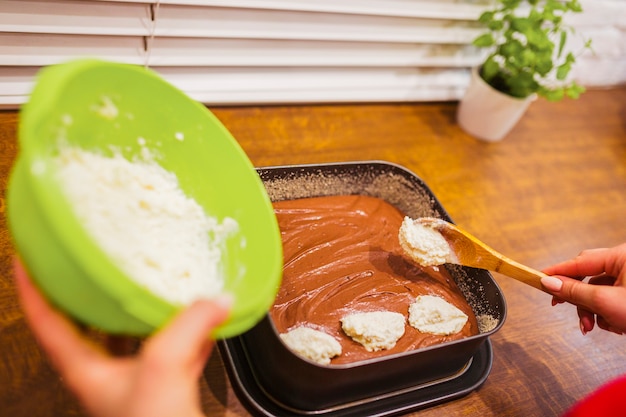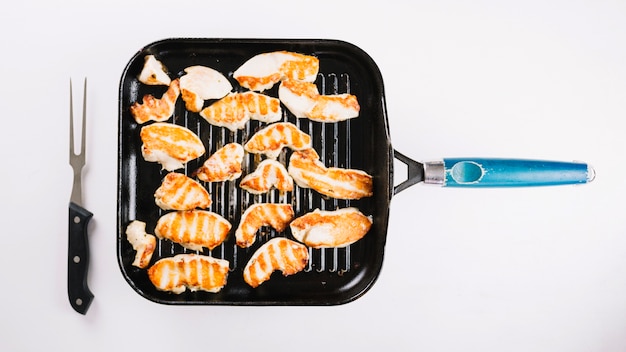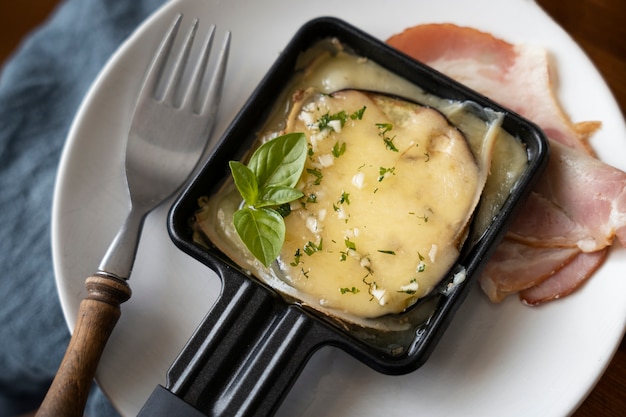There's a certain magic to a perfectly cooked tuna steak. The vibrant flavour, the melt-in-your-mouth texture, and the elegant presentation – it's a true culinary delight. And when you add a touch of buttery goodness, the experience elevates to a whole new level. Today, I'm taking you on a personal journey through my recipe for pan-seared tuna steak, sharing the tips and tricks I've learned over the years to create a dish that's both impressive and incredibly satisfying. Let's dive in!
(Part 1) The Star of the Show: Choosing the Right Tuna

Picking the right tuna is the foundation of a great pan-seared tuna steak. It's not just about grabbing the first piece you see at the supermarket. Trust me, there's a world of difference between those supermarket options and the gems you can find at a good fishmonger. For this dish, you want a tuna steak that's fresh, firm, and possesses a beautiful, deep red hue. It's the colour of a perfect sunset, just waiting to be transformed into a culinary masterpiece.
Finding Your perfect tuna
Now, my personal favorites are yellowfin and bigeye tuna. They're known for their rich, deep flavour and delicate texture, perfect for pan-searing. But don't be afraid to experiment! Albacore tuna is another good option, though it's a bit leaner, so you might want to add a touch more fat to your pan to keep it moist.
The Importance of Freshness
Freshness is paramount. You want to see a vibrant red colour, not a dull, pale shade. The flesh should be firm, not mushy or watery. And of course, a fresh ocean smell is a good sign. If you're not sure, don't be afraid to ask the fishmonger for their recommendation. They're the experts, and they'll help you choose the best piece for your pan-searing adventure.
(Part 2) Prep Work: The Foundation for Success

Before we get to the exciting part of searing, let's talk about the crucial prep work. It might sound a bit mundane, but trust me, these little steps make a huge difference in the final outcome.
Pat It Dry, My Friend
First things first: pat your tuna steak dry with kitchen paper. This might seem like a small detail, but it's vital. A dry surface ensures a beautiful, crispy sear, preventing steam from building up and making your tuna steak soggy. Nobody wants a soggy tuna steak!
Seasoning with Finesse
Now, for the seasoning. A simple pinch of salt and pepper is all you need. Remember, you want to enhance the natural flavour of the tuna, not drown it. Over-seasoning can mask the delicious, delicate taste of your star ingredient. I like to use coarse sea salt for a slightly bolder flavour, but fine salt works just as well.
(Part 3) The Searing: A Culinary Dance

This is where the real magic happens, folks. Pan-searing is a culinary art form, requiring a bit of practice and a good understanding of heat. But don't be intimidated, anyone can master it with a little patience and the right techniques. And let me tell you, a perfectly seared tuna steak is an experience you'll never forget.
The Right Pan: Cast Iron is King
First, you need the right tool for the job. A heavy-bottomed cast iron pan is my go-to for searing. It distributes heat evenly and retains it beautifully, creating a stunning crust that's both delicious and visually appealing. If you don't have a cast iron pan, a stainless steel or non-stick pan will work just fine.
Heat It Up, Baby
Now, crank up the heat! Your pan needs to be smoking hot. This is the key to achieving that gorgeous sear. Don't be afraid of a little smoke – it's part of the process. A hot pan ensures a fast cooking time, resulting in a tender, juicy, and perfectly cooked tuna steak.
Oiling Up for Success
Add a generous amount of oil to the pan, enough to coat the bottom evenly. I prefer to use neutral oils with high smoke points, like grapeseed oil or canola oil. These oils can handle the intense heat without burning, ensuring a clean, crisp sear. Avoid olive oil for searing, as it has a low smoke point and can start to burn before the pan is hot enough. The result? A bitter, burnt taste that will ruin your masterpiece.
The Grand Entrance: Tuna Takes the Stage
Now, carefully place your tuna steak in the pan. Don't crowd the pan, or the tuna won't sear properly. You want each side to have ample space to develop that beautiful, golden-brown crust.
The Sear: A Love Affair with Time
Let the tuna sear for about 2-3 minutes per side. You'll know it's ready when it has a beautiful golden-brown crust and is cooked to your desired level of doneness. Don't overcook it, or you'll end up with a dry, tough steak. If you're unsure, you can always use a meat thermometer to check the internal temperature. The ideal temperature for a medium-rare tuna steak is 125-135°F (52-57°C).
(Part 4) The Buttery Bliss: Adding a Touch of Luxury
Alright, now for the pièce de résistance. The moment we've all been waiting for: the buttery goodness. A knob of butter, sizzling in the pan, infusing the tuna with a richness that's simply irresistible. This is where the dish truly transitions from delicious to divine.
The Butter Melt: A Culinary Symphony
Once your tuna is beautifully seared on both sides, remove it from the pan and set it aside. Add a knob of cold, unsalted butter to the pan. The contrast between the hot pan and the cold butter creates a delightful sizzle. As the butter melts, it will release a wonderful, nutty aroma that fills the air, hinting at the deliciousness to come.
The Butter Glaze: A Delicious Embrace
As the butter melts, tilt the pan and spoon the melted butter over the tuna steak. The hot butter will gently melt over the tuna, creating a beautiful, shimmering glaze that's both visually stunning and unbelievably delicious. This is where that touch of luxury comes in, elevating the entire experience.
(Part 5) Resting Time: A Moment of Patience
Now, before you dive in, let your tuna steak rest for a few minutes. This allows the juices to redistribute, ensuring a tender, succulent, and flavorful steak. You can cover the tuna loosely with foil to keep it warm while it rests. This little pause is essential. It's a reminder that good things come to those who wait.
(Part 6) The Perfect Finish: A Symphony of Flavors
Your pan-seared tuna steak is ready! But don't stop there! It's time to add a few finishing touches to elevate this dish to new heights. This is where your creativity can shine!
The Garnish: A Touch of Elegance
A simple garnish can make all the difference. I love to use fresh herbs, like chopped parsley, dill, or chives. The vibrant green colour adds a touch of freshness and elegance. You could also add a squeeze of lemon or lime juice for a bright, citrusy flavour. Or, if you're feeling fancy, a sprinkle of sesame seeds or toasted breadcrumbs would also be lovely. Let your taste buds guide you!
The Sidekicks: A Perfect Accompaniment
No tuna steak is complete without the perfect side dishes. Here are a few of my personal favorites:
- Roasted vegetables: Asparagus, broccoli, or zucchini roasted with a drizzle of olive oil and herbs. The sweetness of the roasted vegetables complements the richness of the tuna perfectly.
- A creamy salad: A simple salad with a creamy dressing, like a Caesar salad, adds a refreshing counterpoint to the rich tuna steak. Just make sure the salad is light and doesn't overwhelm the main course.
- Lemon-herb couscous: Couscous tossed with lemon juice, fresh herbs, and a little bit of olive oil is a healthy and flavorful side dish that pairs beautifully with tuna.
- Aromatic rice: For a more comforting and satisfying option, consider a bed of aromatic rice, infused with herbs, spices, or even a touch of citrus. The flavour pairings are endless!
(Part 7) The Plate: A Culinary Canvas
Now, it's time to present your masterpiece. A beautifully plated dish elevates the dining experience. Think of your plate as a canvas. You want to arrange your components in a way that's visually appealing and balanced.
The Centerpiece: A Star in the Making
Place your tuna steak in the center of the plate. Make sure it's sliced beautifully, showcasing the delicate pink and red hues of the cooked tuna. The slices should be thin and even, ensuring each bite is a symphony of flavours.
The Supporting Roles: A Symphony of Textures and Flavors
Arrange your side dishes around the tuna steak, creating an attractive and balanced composition. Use different colors and textures to add visual interest. For example, a vibrant green salad, a creamy white couscous, and a colorful array of roasted vegetables will create a truly stunning and delicious presentation.
The Final Touch: A Sprinkle of Magic
Now, add your garnish. A sprinkle of fresh herbs, a squeeze of lemon juice, or a few toasted sesame seeds will add a touch of elegance and fragrance to your dish. You've just created a culinary masterpiece that's both delicious and visually appealing.
(Part 8) The Verdict: A Culinary Triumph
So there you have it, folks. My recipe for Pan-Seared Tuna Steak with Buttery Goodness. It's a dish that's easy to make, yet utterly satisfying. The combination of the perfectly seared tuna, the buttery glaze, and the complementary side dishes creates a culinary symphony that's sure to impress.
FAQs: Your Burning Questions Answered
1. Can I use frozen tuna for this recipe?
While fresh tuna is always the best option, you can use frozen tuna in a pinch. Make sure to thaw it completely in the refrigerator before cooking. Just be aware that frozen tuna may not have the same texture and flavour as fresh tuna. It's a bit like the difference between fresh flowers and silk flowers – the texture and scent are just not the same.
2. What temperature should I cook the tuna to?
The ideal internal temperature for tuna steak is 125-135°F (52-57°C) for a medium-rare finish. This is when the tuna is still slightly pink in the center but cooked through. You can use a meat thermometer to check the internal temperature. If you prefer a more well-done steak, cook to an internal temperature of 140-145°F (60-63°C). Just remember that the longer you cook it, the drier it will become.
3. How long should I rest the tuna steak?
You should rest the tuna steak for about 5-10 minutes before slicing and serving. This will allow the juices to redistribute, ensuring a more tender and flavorful steak. The resting period is like giving the tuna a chance to breathe after its culinary journey.
4. Can I add other ingredients to the butter glaze?
Absolutely! Experiment with different herbs, spices, or citrus juices to create your own unique flavour profile. A touch of garlic, ginger, or even a splash of soy sauce can add a delicious twist. Remember, cooking is all about creativity and exploration! Don't be afraid to experiment and find what you love.
5. Can I make this recipe ahead of time?
While it's best to cook tuna steak fresh, you can sear the tuna ahead of time and then reheat it before serving. To reheat, simply place the tuna steak in a preheated oven at 350°F (175°C) for 5-10 minutes, or until heated through. However, I highly recommend enjoying this dish fresh for the best flavour and texture. The freshness of the tuna and the warm, buttery glaze create a truly unforgettable experience.
Everyone is watching

Corn on the Cob: The Ultimate Guide to Perfectly Cooked Ears
Healthy MealsAh, corn on the cob. Just the name evokes images of sunny days, barbecues, and that sweet, juicy flavour that ...

Scallops: The Ultimate Guide to Perfect Cooking
Healthy MealsAh, scallops. Those delicate, sweet, and utterly delicious morsels of the sea. They hold a special place in my...

Spaghetti Squash: The Ultimate Guide to Cooking and Serving
Healthy MealsRemember that time you saw spaghetti squash at the supermarket, looking all bumpy and strange, and thought, "W...

Salmon Cooking Times: Perfect Guide for Every Recipe
Healthy MealsLet me tell you, cooking salmon is an art form. It's all about getting that perfect balance: juicy and tender,...

Ham Cooking Time: How Long to Bake, Smoke, or Boil a Delicious Ham
Healthy MealsAh, ham. It's a classic, isn't it? A real crowd-pleaser, especially around holidays. And when done right, it'...
